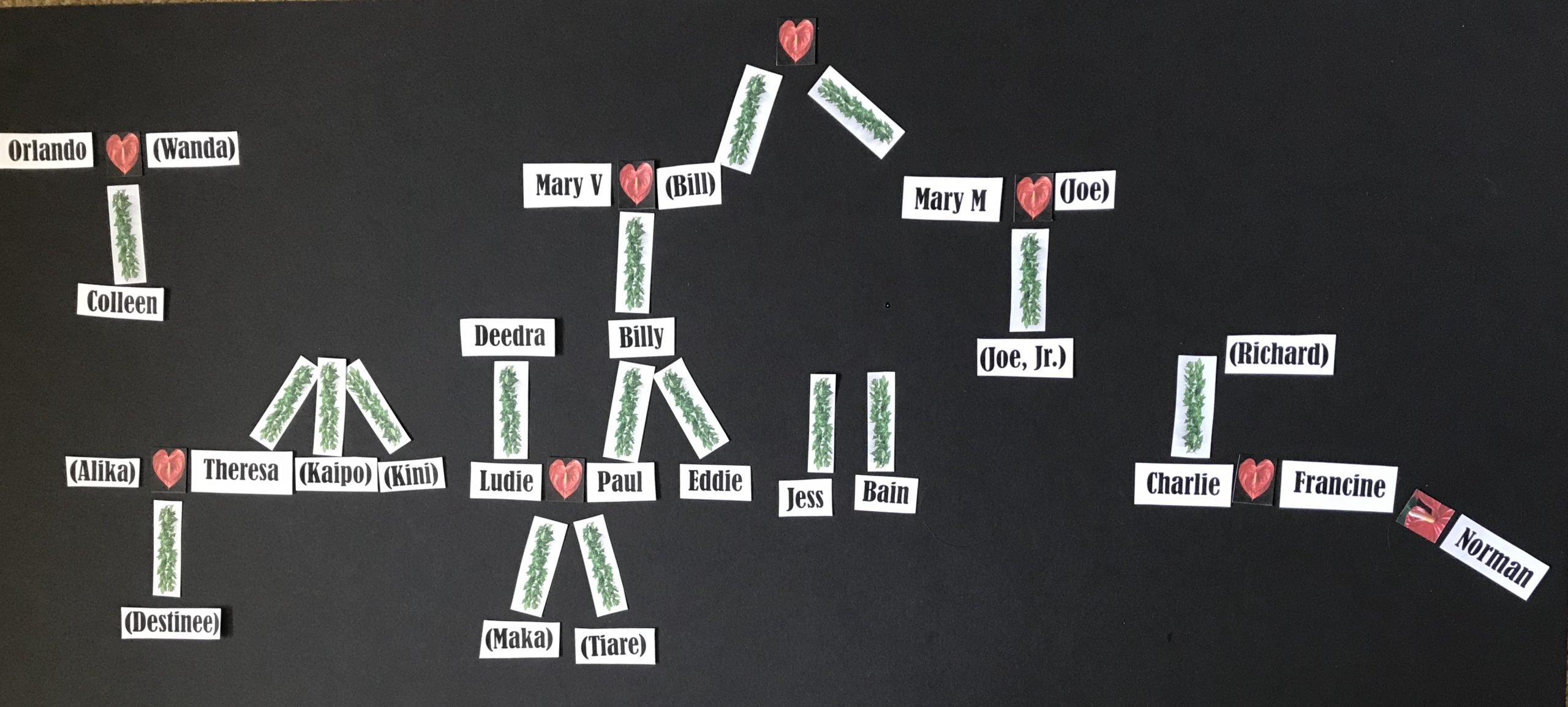

















Flowers of Hawai`i: More About the Play
Lee Cataluna

Popular, multi-award-winning playwright Lee Cataluna was born on Maui. Her father, Donald Cataluna, was a third-generation sugar industry laborer who put himself through the University of Hawaii and later became manager at Wailuku Sugar on Maui, Olokele Sugar on Kauai and Hilo Coast Processing on Hawaii Island. For young Lee this meant frequent school changes, calling new neighborhoods home, making new friends, and encountering new stories.
Years later, Lee Cataluna’s openness and sensitivity to the rich cadences of Hawaii’s local voices and the stories of ordinary people would contribute to her success as a broadcast journalist, newspaper columnist, fiction writer, and playwright. Widespread public and critical acclaim for her literary work is reflected in the 2003 Cades Award for Literature and in the Hawai’i Book Publishers Association’s Ka Palapala Po’okela Awards for Folks You Meet in Longs and Other Stories in 2006 and Three Years on Doreen’s Sofa in 2012.
Lee Cataluna’s debut play The Mayah premiered at the Kumu Kahua Theatre in 1998, setting a new box-office record. The Hawai’i State Theatre Council’s Po’okela Awards for original script recognized her artistic achievement in the 2003 musical You Somebody (music by Keola Beamer), commissioned by Diamond Head Theatre, and Flowers of Hawaii, presented by Kumu Kahua Theatre in 2014. Other works for the stage include: The Great Kauaʻi Train Robbery (2010) and Ulua: The Musical (1999, music by Sean T.C. O’Malley). Her new play Aloha Attire recently premiered at Kumu Kahua Theatre.
National recognition followed through prestigious commissions, creative developments, and special features. In 2018, Lee Cataluna was named among the 100 most prominent Native American theatre-makers in the country by the American Theatre journal. Co-commissioned by La Jolla Playhouse and the Honolulu Theatre for Youth, her Home of the Brave (2018) explores the experiences and resilience of children from military families. Flowers of Hawaii was featured in the 2019 Native Voices Festival of New Plays at the Autry Museum of the American West in Los Angeles and was selected for creative development in 2018 by New York City’s Out of the Box Theatrics.
Having earned an M.F.A. in Creative Writing from the University of California, Riverside, Lee Cataluna maintains a prolific dual career as a journalist and playwright. She is currently a columnist for Civil Beat. Her one-act play “What the Stars See at Night” (2020) is part of La Jolla Playhouse’s “Play where you are” initiative, while her musical “Ke Kula Keiki Ali’i: The Royal School,” written in collaboration with Moses Goods, will be produced in the future by the Honolulu Theatre for Youth.
On Santa Anita Pottery’s “Flowers of Hawaii” Dinnerware Line

Cherished for its mid-century modern design, and now a valuable collectible, the Hawaiian-themed dinnerware among Santa Anita Pottery’s lines includes the “Flowers of Hawaii” and “Hawaiian Luau” which brought together both elegance and affordability to Hawaiʻi’s households in the 1940s and 1950s. This was possible because the colourful floral designs were transferred onto the ceramics instead of being hand painted. The “Flowers of Hawaii” dinnerware line includes nine patterns: yellow hibiscus, monstera, bird of paradise, shell ginger, red anthurium, night blooming cereus, cup of gold, croton and torch ginger. Each of them is evocatively woven into the dramatic texture of Lee Cataluna’s play, providing inspiration and contributing layers of distinct visual quality.
While pursuing her M.F.A. in Creative Writing at the University of California at Riverside, just 50 miles south-east of Santa Anita, Cataluna saw the “Flowers of Hawaii” dinnerware in various antique stores in the Los Angeles area and started associating it with home, family, and particularly with her grandmother. As the nine elegant floral designs were popular wedding gifts in Hawaii in the 1950s, in Cataluna’s play they give a glimpse into a remembered graceful era in recent island history and a lifestyle, coveted by the younger generations but ultimately beyond their reach. In a 2013 interview with Daniel Akiyama, the playwright indicated that the nostalgic effect created by the “Flowers of Hawaii” designs made her think of the dramatic possibilities afforded by the dynamics between family expectations and lived experiences.
Santa Anita Pottery opened in 1939 to meet the increased demand for dinnerware when World War II disrupted European and Asian imports. At the height of their popularity in the late 1940s and 1950s, the “Flowers of Hawaii” patterns were considered lucrative tie-ins with Hollywood. A case in point is Delmer Davis’ The Bird of Paradise. Filmed in 1951 in Hawaii for Twentieth Century Fox and starring Debra Paget and Louis Jordan, it used Santa Anita Pottery’s “Bird of Paradise” dinnerware in a mutually advantageous advertisement campaign. The picture was a screen adaptation of Richard Walton Tully’s 1912 play with the same title which, according to studio publicity, featured Native Hawaiian Prince Lei Lani as the Kahuna in the play’s original production. The popular song “Kuʻu Lei ʻAwapuhi” (words & music by Emily Kekahaloa Namauʻu Taylor) was composed for the film. Santa Anita Pottery folded its operations in 1957, unable to withstand the mounting pressures from cheaper Asian imports.
Aloha Attire

Lee Cataluna’s newest play Aloha Attire streams online November 5-22, 2020 at Kumu Kahua Theatre. Written specifically for digital theatre, it is a prequel to Flowers of Hawaii. In her playwright’s notes for Kumu Kahua, Cataluna traces the play’s genesis to a series of inspiring experiences: participating in the Native Voices Festival at the Autry in 2019, a conversation with Director Lurana Donnels O’Malley earlier this summer about staging Flowers of Hawaii at UHM’s Kennedy Theatre, and finding her old gold dipped maile leaf pendant in a box of family mementos.
This discovery gives rise to the play’s framing narrative: unpacking a box of her mother’s belongings offers twenty-something Des delightful opportunities to “unpack” both her mother’s past and a series of family relationships which transport audiences back to Hawai’i of the 1980s. The metaphor acquires further comic intensity when Des puts it all on display in her live Youtube channel. In a world of physical distance, this is her way of maintaining emotional proximity to family, friends, and the local community across three generations, not to mention the numerous complete strangers online.
Audience members able to see both shows will recognize the family tree that shapes the world which the plays share. Des is Theresa’s daughter, while Mary V is the great-grandmother who (unnamed in Aloha Attire) holds the family together. Aunt Kini is Theresa’s younger sister — we see her only at the funeral receptions bookending Flowers of Hawaii. In search of redemption, creepy Uncle Billy makes a significant comeback in Flowers, though Theresa’s animosity towards him remains undiminished.
Dramaturgical notes by Maggie Ivanova.
Family Tree

This family tree was created by Director Dr. Lurana O’Malley and approved by playwright Lee Cataluna. This shows how the characters of the play are connected and how closely their familial ties and stories are interwoven through the course of the play. Red anthurium blossoms indicate marriages, and maile leaves indicate parent-child relationships. Characters in parentheses do not appear in Flowers of Hawai’i, but may be characters in Aloha Attire.





